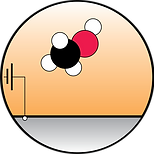
Research & Experience


Biomass valorization


Electrosynthesis


Solar Water Splitting


Solar cells
Research & Experience
Biomass Valorization
We have all grown up knowing that most of the products that we use and consume on daily basis originate from petroleum, after sophisticated treatments in refineries and specialized downstream processing. Likewise, we all know that this situation is not sustainable: the concerning emissions associated with these processes and the depletion of oil reserves are the cause. Therefore it is necessary to reimagine the ways we source the chemical building blocks that sustain our industry and our way of living to make it compatible with the environment. Biomass, and particularly, lignocellulose, which refers to forestry and agricultural waste, has been identified as a potential source for those petrochemicals that we are heavily consuming today. Now, could we establish a competitive and clean technology capable of turning waste biomass into value-added chemicals? There are several technologies under investigation to address this question.
In the framework of the RELICS project we will address this question exploring the possibility of mining the petrochemicals that are locked inside the biomass by using electrochemical and solar-driven technologies.

Electrosynthesis
In recent years the advances in materials science and in the understanding of electrocatalysis has prompted an interest in electrifying the chemical industry. Imagine a traditional chemical process in industry, that is, one that requires copious amounts of chemicals (oxidants or reductants), energy-intensive conditions (high pressure and/or temperature) to activate the reaction and normally large facilities to make profits. Now, suppose that this reaction could well be mimicked in an electrochemical reactor where the “chemicals” that trigger the reaction are generated in-situ with electricity. In this ideal situation, electricity would replace the “chemicals” and we would not need energy-intensive and costly operating conditions; we could even think about small modules that could decentralize the “chemical process” anywhere. This is the general idea behind electrifying the chemical industry.
We are particularly interested in applying electrochemical technologies to enable “circularity” in the economy, for instance, recycling flue gas (with high CO2 content) into economically-relevant products such as hydrocarbons that could be fed back into the industry.

Solar Water Splitting
The demand for hydrogen in the worldwide market is one of the largest, about 50 million tons, and this can be accounted for by its active participation in the Haber-Bosh process for the synthesis of ammonia, in the Fischer-Tropsch synthesis, etc. However, the synthesis of H2 mainly relies on steam methane reforming, a highly optimized process that unfortunately releases a large amount of CO2. Finding alternative ways to produce “green” hydrogen is one of the key objectives of several initiatives launched at a European level, which gives an idea of how important and urgent it is to transition to a “cleaner” and economically-competitive approach to produce hydrogen. There are several candidate technologies to accomplish that, and I had the chance to work on one of them during my postdoctoral stage at EPFL within the group of Prof. Sivula, a leading laboratory in photoelectrochemical (PEC) cells for water splitting. Probably one of the first ideas that comes to mind when we think about producing clean hydrogen is to couple an electrolyzer to split water into hydrogen and oxygen with a solar cell. Although this technology is very mature, several studies suggest that another technology, the PEC cells for water splitting, where the electrodes of the electrolyzer not only carry out water oxidation and reduction reactions but also absorb light to drive the process, could bring the cost of hydrogen even lower.
We are particularly interested in developing new materials for solar water splitting and in understanding which factors govern the performance. We work in close collaboration with GFES at the University of Alicante, who is leading a European consortium that aims at bringing PEC water splitting closer to the market (FOTOH2).

Solar Cells
Turning sunlight into electricity is probably one of the best approaches to decentralize the production of electricity and bring it literally anywhere where there is light. However, only a very small fraction (1.3 %, US 2019) comes from this technology. Lowering the production costs (cheaper solar cells) and enabling devices that are flexible, light-weight and semitransparent could accelerate the permeation of these devices into our everyday life. There exist a wide range of device architectures and materials to accomplish this goal, but solution-processed devices appear as the most promising candidates.
One set of such solution processed candidates are the sensitized mesoscopic solar cells where a “light harvesting material”, like a dye molecule, is anchored into a mesoporous scaffold, typically a mesoporous oxide, and in contact with an electrolyte or polymer, being these two phases in charge of the extraction and collection of the photogenerated charges in the light harvesting material. I had the opportunity to work on them during my PhD at GFES, particularly the so-called Quantum Dot-Sensitized Solar Cells (QDSSCs), where Quantum dots are used as antennas to harvest the light. Another type of technology whose efficiency is scaling very rapidly is the one of Organic Solar Cells (OSCs). Here a couple of organic semiconductors (a donor and an acceptor) are intermixed in a very specific fashion that renders continuous nanochannels of each one of the semiconductors (bulk heterojunction architecture) to afford not only the exciton dissociation at the interface of both phases but also the uninterrupted transport of the photogenerated electron and hole through the acceptor and donor, respectively. I had the chance to work on this class of devices at LIMNO, where the design and customization of organic semiconductors for photovoltaic and photoelectrochemical application are key objectives.




